Illinois
Illinois hosts more Lithuanian-Americans than any other state. It is second only to Pennsylvania in terms of Lithuanian heritage sites.
The key Lithuanian areas of Illinois include:
*The grand historic Lithuanian districts of southern Chicago.
*Some of Chicago's western suburbs.
*Several industrial cities (Rockford, Springfield, Waukegan, Kewanee, East St. Louis).
*A few coal mining towns in central and southern Illinois (Spring Valley area, Westville area, West Frankfort area).
*Furthermore, there is an extensive "Lithuanian Riviera" east of Chicago that continues far beyond Illinois state limits, hugging the shores of Lake Michigan.
Each of these areas has a significantly different Lithuanian vibe, history, as well as heritage sites that one may still visit today.
Here we introduce every area (with links to longer articles about each one of them) and conclude the article with the general Lithuanian history of Illinois.

Cicero St. Anthony Lithuanian church in Chicagoland, one of the big pre-war Lithuanian churches that served as the hubs of Chicagoland's Lithuanian districts
Chicago, its Lithuanian districts and suburbs
Chicago is considered to be not only the „Lithuanian capital of Illinois“ but also the „Lithuanian capital of Americas“ or even the „Lithuanian diaspora capital of the world“, and it has been so since at least 1910s.
The facts are nothing less than stunning: before World War 1, Chicago had more ethnic Lithuanians than any city in Lithuania itself (almost 100 000). Right until the 1980s, there were more Lithuanian-language churches in Chicagoland than in any other city in the world (Lithuania itself included).

Holy Cross Lithuanian church in Chicago (Back of the Yards), built in the 1910s, is the largest Lithuanian church of Chicago
In effect, the Chicago Lithuanian community was way too big to cram itself into a single Lithuanian district. Instead, Chicago's southside became dotted by such Lithuanian districts, each centered around a Lithuanian church but gradually expanded by Lithuanian halls, Lithuanian convents, Lithuanian schools, Lithuanian businesses, and Lithuanian monuments. Chicago has a few Lithuanian architectural masterpieces that have no pars in Lithuania itself, while some of Chicago's Lithuanian churches are among the largest and most opulent Lithuanian churches in the world. Each of them serves not only as a religious hub but also as a secular hub for Lithuanian activities.
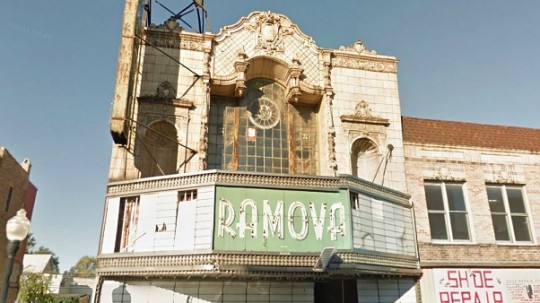
Ramova Lithuanian-owned cinema, named after Lithuanian pagan temple (Bridgeport, Chicago)
There were two key eras of Lithuanian district expansion in Chicago during which most of the city's Lithuanian buildings and monuments were built. The first era covered ~1900s-1920s, propelled by Lithuanians who came to work in Chicago's industry, escaping their poor Russian-ruled country. The second era was ~1950s-1960s when tens of thousands Lithuanian refugees who fled the Soviet Genocide were relocated from the refugee camps in Europe to Chicago, wishing to establish "Little Lithuanias" all over the city.
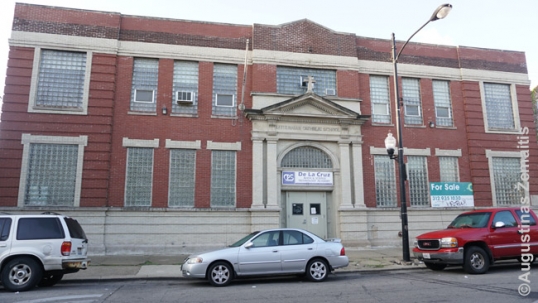
Our Lady of Vilnius church/school in the Heart of Italy district of Chicago. It is an example of a 'temprorary building' that served both as a church and as a school. In many cases, as Lithuanian communities grew larger and more affluent, these were augmented by a separate larger church building, however, not here
Many of Chicago's Lithuanian buildings survive, however, all of the historically Lithuanian districts became Black or Hispanic majority in the 1970s-1990s. Lithuanians moved away to the Chicago suburbs. There is no single Lithuanian suburb, though, as in the era of the automobile (unlike in the early 1900s), Lithuanians could easily live in one part of Chicagoland and go to the activities in another. Some Lithuanians thus still frequent the historic Lithuanian hubs in the inner city for Lithuanian Mass or activities. Others, however, are mostly attached to the new Lithuanian hub, known as Lithuanian World Center, established in 1980s in the Lemont suburb. Lemont thus became the unofficial capital of Chicago's Lithuanian suburbia with many Lithuanian-American organizations headquartered therein. While some Lithuanian public activities remained in Chicago itself, nearly all Lithuanian businesses (e.g. restaurants) moved to the suburbs, especially to the Lemont-Westmont area.

Lithuanian restaurant in Westmont area
Correlating with the general Inner City vs. Suburbs vibe trend in the USA, the Lithuanian buildings of Chicago suburbs are different than those in the historic districts. They are more oriented towards function than grandeur or Lithuanian artworks, and many of them are generic-looking from the outside. That said, the Lemont area has received some impressive Lithuanian monuments.

Symbolic Hill of Crosses built at the Lithuanian World Center in Lemont to imitate the original Hill of Crosses near Šiauliai, Lithuania
In Chicago city itself, Marquette Park is the largest Lithuanian district outside Lithuania to have ever existed (population of 40 000 in the 1960s), as evident in its massive monuments and buildings. Other key Lithuanian hubs include(d) Back of the Yards, Brighton Park, Gage Park, and Cicero, where a lot of heritage still survives. Bridgeport was a massive Lithuanian district that unfortunately had most of the Lithuanian buildings demolished. Lithuanian buildings still survive in Roseland, Pilsen, Chicago Heights, South Chicago, and West Pullman albeit none of these are in Lithuanian operation.

Corronation of Mindaugas mosaic at the Nativity BVM Lithuanian church
Generally, in the historically smaller or older Lithuanian districts, the Lithuanian life died out and the institutions closed soon after the "white flight", while in the larger and newer districts, some buildings are still in Lithuanian use. Typically, the districts with Hispanic majorities fare better than those with African American majorities, because, among other reasons, Hispanics, like Lithuanians, are generally Roman Catholic, and so they joined the Lithuanian churches, helping them survive even after most Lithuanians moved out.
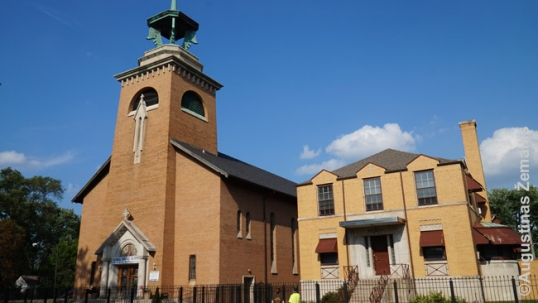
Roseland All Saints Lithuanian church (now non-Catholic, African American)
In addition to local institutions within each single Lithuanian district of Chicago, Lithuanians have established some pan-Chicago Lithuanian institutions. These include two Lithuanian cemeteries notable for their grand Lithuanian tombstones created by famous sculptors, as well as numerous famous burials. These two cemeteries - the Catholic St. Casimir and the religion-neutral Lithuanian National Cemetery - are the largest and most famous Lithuanian cemeteries outside Lithuania and they also serve as repository for Lithuanian memorials. Meanwhile, Lithuania's Jews have created their zones in the Waldheim Jewish cemetery.

Lithuanian coat of arms land art at the St. Casimir Lithuanian cemetery of Chicago
Moreover, Lithuanian museums and archives of Chicago became not only the main hub for Lithuanian-American history research but also for free Lithuanian research altogether in the times while Lithuania was Soviet-occupied (1940-1990). The most famous among museums are the Balzekas Museum and the Lithuanian Art Museum within the Lithuanian World Center.
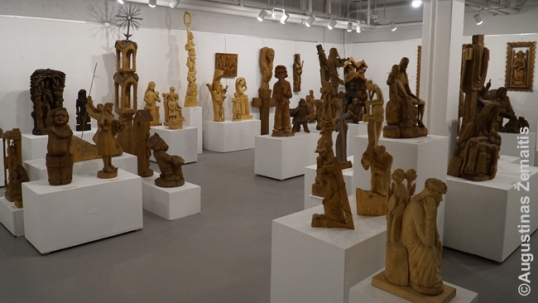
Lithuanian wooden arts at the Lemont museum
Lithuanians of the smaller industrial cities of Illinois
Several smaller industrial cities of Illinois are like mini-Chicagos in terms of their Lithuanian heritage and history. Like in Chicago, the main bulk of Lithuanians immigrated to those cities before World War 1, attracted by industrial jobs.
Unlike Chicago, however, each of these cities had just a single Lithuanian area, centered around a single Lithuanian church and, in many cases, a Lithuanian club and/or a Lithuanian school. Also, the communities there were never large enough to establish their own Lithuanian cemeteries.
Industrial cities of Illinois that became Lithuanian hubs include:
*East St. Louis, with its Modern-Lithuanian-style church that is among the best examples of this style in the world.
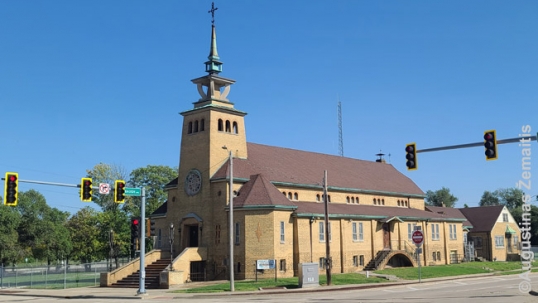
Immaculate Conception Lithuanian church of East St. Louis
*Rockford, with its Lithuanian church, club, park, and exhibits in a local museum.
*Springfield with its Lithuanian church which has been demolished but a memorial plaque now reminds it.
*Waukegan, with its Lithuanian church and club.
*Kewanee, with its Lithuanian church.
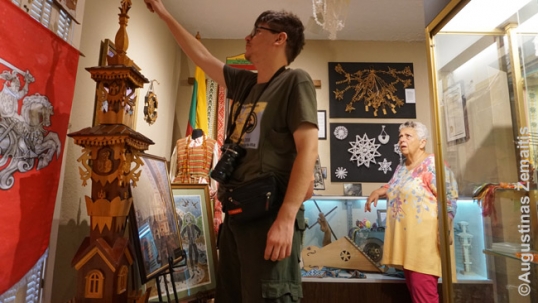
Rockford Ethnic heritage museum Lithuanian room
Each of these cities also had numerous Lithuanian businesses. Unlike Chicago, however, the smaller industrial cities attracted fewer new immigrants after World War 2, and so Lithuanian life declined there faster, with many older Lithuanians eventually assimilating or moving out. As such, all the businesses closed or became non-Lithuanian, and so did most of the churches and other institutions.
Two additional such industrial cities are located in Indiana but very close to Chicago. Their history mimics that of Illinois's industrial cities:
*East Chicago, with its Lithuanian church (demolished).
*Gary, with its Lithuanian church and school.

Lithuanian inscription on the Gary Lithuanian church stained-glass window survives despite church being no longer in Lithuanian use
Lithuanian coal mining towns of Illinois
Illinois's coal mining towns developed in the same era as the industrial cities. However, they were much smaller, having a population numbering in just four or lower five digits.
As pre-WW1 Lithuanians would often migrate to the same areas in their thousands, some of the Illinois coal mining towns possibly even became Lithuanian-plurality or Lithuanian-majority sometime around World War 1 (although the exact Lithuanian percentage in each one of them varies according to different sources).
The most Lithuanian towns included Spring Valley and Westville, where most Lithuanian heritage exists.
Likely a lower percentage of ethnic Lithuanians existed in Oglesby, West Frankfort, Ledford, and Johnston City (or Lithuanians moved out from there earlier, leaving less heritage).
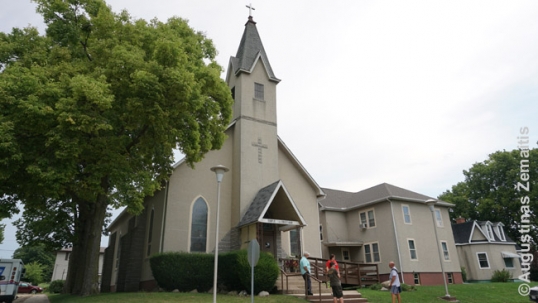
Spring Valley St. Anne Lithuanian church
Given that all of these were small towns with ample land available, Lithuanians were able to establish their own cemeteries in each of them (except for Oglesby). In fact, in Spring Valley and Westville, they established two Lithuanian cemeteries in each town (based on differing religious views). While they built just a single Lithuanian church in Spring Valley and a single one in Oglesby, they actually built two Lithuanian churches (of different denominations) in Westville. In any case, these churches and other Lithuanian buildings were generally more modest than in the main cities of Illinois.
Unlike the Illinois industrial cities and Chicago, the mining towns received nearly no new immigration (Lithuanian or otherwise) after World War 1 and, in fact, younger people have been slowly-but-surely moving out. However, with such strong initial Lithuanian communities percentage-wise there still exist significant numbers of Illinois-mining-town-born people who are 50% to 100% of Lithuanian descent and thus are keen on their heritage (although the Lithuanian language has nearly completely "died out" in the area). Often, they volunteer in taking care of the numerous Lithuanian cemeteries.
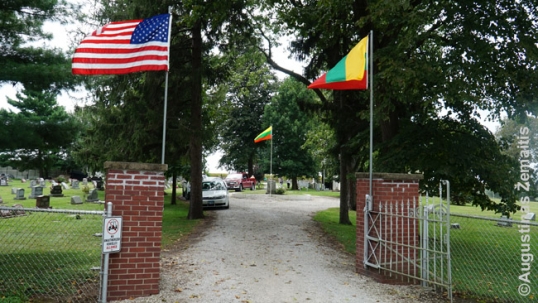
One of the entrances to the Westville Lithuanian cemetery
In addition to all these "typical" Lithuanian coal miner settlements, Illinois also has Collinsville, which is the only town of America to have attracted its Lithuanian population mostly from Lithuania's Lutheran minority rather than Catholic majority. Collinsville thus has a Lithuanian Lutheran church.
Chicagoland's Lithuanian Riviera
While not exactly part of Illinois, northern Indiana and even southwesternmost Michigan effectively became a continuation of Chicago's Lithuanian life. Several lakeshore resorts there became effectively Lithuanian, especially Beverly Shores, IN, and Union Pier, MI.
The primary reason why Lithuanians chose these resorts was their massive sand dunes that reminded Lithuanians of the Lithuanian shores (e.g. Palanga, Neringa).

Lituanica park memorial stone
It all started ~1950s with Chicago Lithuanians sending their housewives and children to spend summers in these Michigan Lake shores (the husband would typically join them in weekends only). Later, many of these families retired there, establishing permanent Lithuanian communities. Even later, as living in distant suburbs became the norm, these retirees were joined by commuters who would commute to Chicago.
Some of these restores effectively became some of the most ethnically Lithuanian towns anywhere in America, with 10%+ Lithuanian population in Beverly Shores, Indiana. Lithuanians lithuanized the landscape by building several monuments in the area. There were many Lithuanian hotels, one of them even owned by the future president of Lithuania Valdas Adamkus, although they closed down over time.
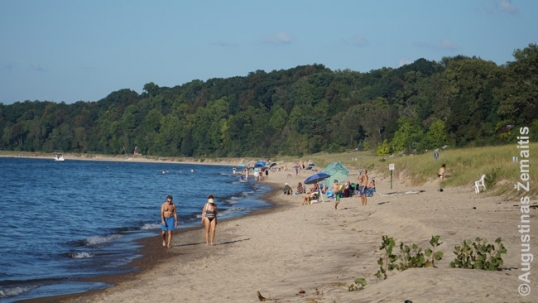
The beach at Union Pier resort
Illinois's Lithuanians also played a vital role in establishing the Lithuanian camps deeper into Michigan. The idea behind these pristine Lithuanian parks was to have an area for Lithuanian children to spend at least a couple of weeks in summer surrounded by other Lithuanian children from all over Midwest (see the articles on Manchester and Custer to learn more about these camps).
Lithuanian history of Illinois
The Lithuanian grandeur of Illinois mostly dates to the late 19th and early 20th century, when developing Illinois industry (primarily the Chicago stockyards) attracted some hundred of thousand Lithuanians from their Russian-occupied agricultural homeland, where the Russian regime was discriminating ethnic Lithuanians.
These so-called First Wave Lithuanian-Americans spoke little English, hindering their ability to integrate. Moreover, the National Revival was going on strong in their own country, so many of these immigrants were also ideologically inclined to "keep the Lithuanian flame going" even after emigration. They put lots of their money and energy into erecting Lithuanian buildings to serve as their community hubs (Lithuanian schools, churches, clubs). The existence of these Lithuanian districts in Illinois helped to perpetuate the Lithuanian language and traditions into the next generations, as Lithuanians were likely to marry other Lithuanians, and even their America-born children were typically surrounded by an entire neighborhood Lithuanian-speaking children; they also attended the Lithuanian parish schools.

Cicero St. Anthony Lithuanian school and church
The numbers of new Lithuanian immigrants to Illinois dried up with the US immigration restrictions, as well as the declaration of Lithuanian independence (1918). Yet, Lithuanian districts of Illinois continued to be expanded by new buildings and institutions, as the previous immigrants were finally achieving their "American Dream" of financial sufficiency, allowing them to spend even more on the Lithuanian causes.
Illinois Lithuanian community was internally divided along the religious/political lines. In addition to the religious Catholic majority, there were leftist, nationalist, and Lutheran minorities-within-minority. In Chicago, each of those groups had its own buildings (often in the same Lithuanian districts) but in the smaller Lithuanian communities of Illinois, the Lithuanian public life often went on around the Lithuanian Catholic church. Also, there were numerous people of Lithuania's ethnic minorities who immigrated (Poles, Jews) - however, typically did not see themselves as Lithuanians at all, integrating into a wider community of their own on ethnicity basis (e.g. Jewish-Americans or Polish-Americans).
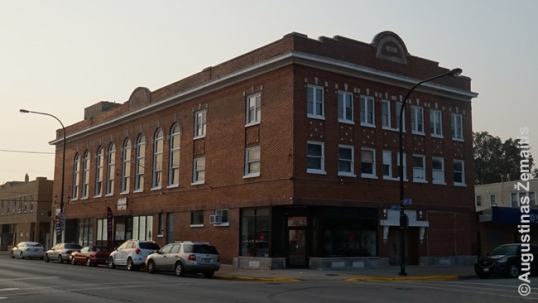
Lithuanian Liberty Hall of Cicero (leftist)
The face of Illinois's Lithuanian districts was transformed once again after 1940s, when Soviet Union occupied Lithuania and began a genocide there. This persecution of an unheard-of scale unleashed the second wave of Lithuanian immigrants to the USA. Most of these refugees were initially supported by their friends and relatives who immigrated decades ago, and so they settled in the same Lithuanian districts. Thus, very large numbers of them settled in Illinois. Chicago became their capital as well, with smaller numbers settling down in the other Illinois industrial cities (but very few moving to the already-economically-unattractive coal mining towns).
These refugees saw themselves as exiles rather than emigrants (as they would have never left Lithuania if not for the Soviet Genocide), and they also considered themselves to be the sole hope for the survival of the Lithuanian language and culture (given that the Soviets were able to easily destroy it back in Lithuania itself). So, this wave of Lithuanians of Illinois was even keener to establish Lithuanian institutions. While the First Wave (pre-WW1) of Lithuanian immigrant was almost entirely blue-collar, the Second (post-WW2 refugee) wave also included many of the top-level famous Lithuanian artists and architects. This allowed a plethora of new Lithuanian buildings, monuments, and other creations in Illinois to reach both the top level of artistic creativity and the top level of Lithuanian ethnic and historical symbolism. In fact, an entirely new unique Modern Lithuanian architectural style was largely created in Illinois, with most of its best examples located within the state (East St. Louis and Marquette Park area of Chicago). Some of the Illinois's Lithuanian artworks are considered to be among the top Lithuanian artistic expressions of the era anywhere in the world.
In the areas where there were fewer these Second Wave Lithuanian immigrants, they simply integrated into the First Wave institutions, replenishing them and re-lithuanizing them but not rebuilding them from scratch.
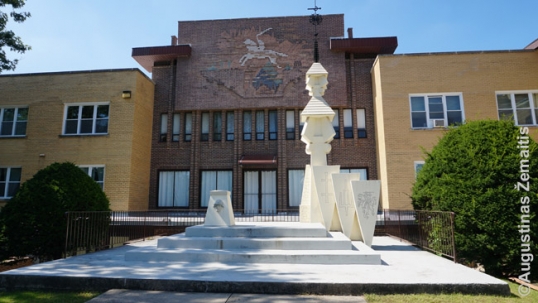
Lithuanian Youth center facade with Vytis and the memorial to those who died for Lithuanian freedom in front. It was built in the Modern Lithuanian style by the post-WW2 refugees
Throughout the Soviet occupation of Lithuania (1940-1990), Chicagoland remained the global capital of "Free Lithuanian thought", hosting diverse institutions ranging from the free world's only Lithuanian opera company to global Lithuanian archives. The Lithuanian geography within Chicagoland changed rapidly, however, in the 1960s-1980s, as the African American Civil Rights movement led to sometimes forceful movement of African Americans from the southeast into the historically Lithuanian districts (while Lithuanians were not the real/primary target, their districts happened to stand in the way between the African-American districts and the affluent "Old White" districts of central and northern Chicago). Increased crime rates made many Lithuanians to move out of their districts into the western suburbs or even northern Indiana. Unlike the former inner-city Lithuanian districts, no suburb ever became Lithuanian-plurality, hastening the assimilation of Lithuanians. To most Lithuanians at the time, any Lithuanian activities became accessible solely through a long drive from home, and there were very few (if any) Lithuanian neighbors, classmates, or workmates, in start contrast to the situation they enjoyed in the inner city Lithuanian districts.
The Lithuanian institutions of the once-smaller Lithuanian districts quickly folded as too few people would have continued coming there. Similar "white flight" happened in the other industrial cities of Illinois as well, most strikingly in East St. Louis. However, it did not take place in the coal mining towns.

Abandoned Lithuanian pub in Marquette Park
After 1990, when Lithuania became independent, Chicago (and to a much lesser extent a few other Illinois cities) received the so-called Third Wave economic migrants from the now-independent but economically-ravaged Lithuania. Like the First Wave, they often spoke no English. However, after some attempts to resettle a few historic Lithuanian districts, they dispersed across the suburbs.
After Lithuania joined the European Union in 2004, Lithuanian emigration reached proportions larger than ever before. However, the EU membership allowed an easy option to legally migrate to the Western Europe which quickly outcompeted the more cumbersome process of emigration to the USA. Therefore, in a matter of a single decade, Western Europe replaced the USA as the prime area of Lithuanian diaspora, while London (UK) area surpassed Chicago area in the number of ethnic Lithuanians.
That said, due to a massive history, grand Lithuanian institutions, artworks, and buildings, as well as generations of Lithuanians willing to "keep the Lithuanian flame going" and invest their hard-earned money and energy into that, Lithuanian culture in Illinois is still arguably much more visible and potent than that in any single European country (besides Lithuania itself and maybe Poland's Punsk area).
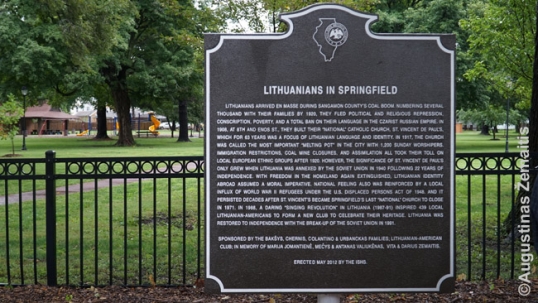
Lithuanians in Springfield commemorative plaque
The map
All the Lithuanian locations, described in this article, are marked on this interactive map, made by the "Destination Lithuanian America" expeditions (click the link):




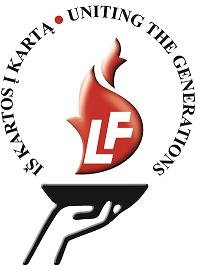

Leave a comment